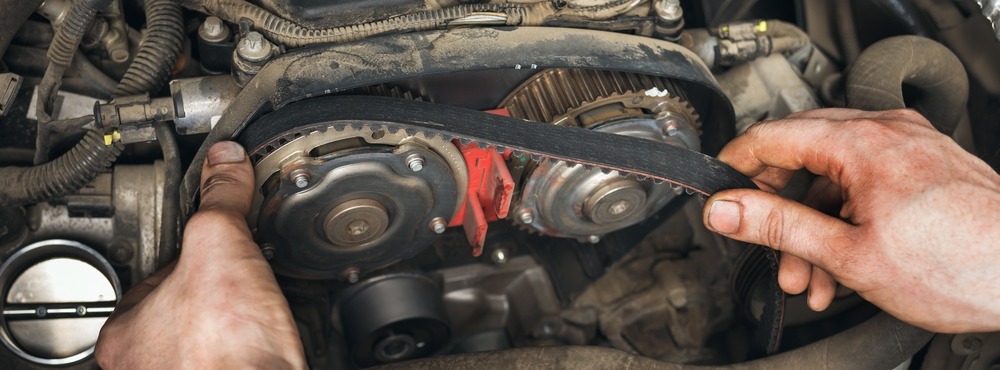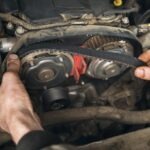
30 Apr Does Your Car Have A Bad Timing Belt? Warning Signs Review
 Did you know that most Americans keep their cars for 12 to 14 years, according to The Bureau of Transportation? Considering most people drive about 14,000 miles yearly, our vehicles can easily pass the 100,000-mile marker. If your car is over 4 years old or has exceeded 60,000 miles, consult your auto shop about your timing belt lifespan. Scheduling engine maintenance is especially important if you experience power loss or engine ticking, which can point to a bad timing belt.
Did you know that most Americans keep their cars for 12 to 14 years, according to The Bureau of Transportation? Considering most people drive about 14,000 miles yearly, our vehicles can easily pass the 100,000-mile marker. If your car is over 4 years old or has exceeded 60,000 miles, consult your auto shop about your timing belt lifespan. Scheduling engine maintenance is especially important if you experience power loss or engine ticking, which can point to a bad timing belt.
With new car prices and insurance rising every year, it’s financially wise to invest in auto maintenance vs. buying a new vehicle. Taking care of older vehicles is vital for their reliability and safety, and it’s beneficial for our pocketbooks, too. So, Let’s review the warning signs of a failing timing belt and why replacing it before it breaks is so important.
What Is A Timing Belt?
A timing belt synchronizes the combustion cycle of your vehicle’s engine by connecting the crankshaft and camshaft. What does that mean? Well, like a conductor in a marching band, the belt keeps a steady beat or timing in the engine. The crankshaft moves in rotation with the pistons, and the camshaft controls the motion of the intake and exhaust valves.
The timing belt connects them to keep the process going in a carefully timed rhythm so the engine works effectively without damage.
What Is It Made Of?
Timing belts for modern vehicles consist of natural rubber or synthetic rubbers (like neoprene, polyurethane, or highly saturated nitrile) with strong, high-tensile reinforcing fibers of Kevlar™, polyester, or fiberglass. These fibers reinforce the length of the belt to reduce stretching out with use. Timing belts have specially shaped and sized horizontal teeth formed onto one side of the belt to engage the pulleys of the crankshaft and camshaft.
How Long Does It Last?
Several auto manufacturers recommend timing belt replacement at 60,000 – 100,000 miles or 4 – 10 years (whichever comes first). Since every car and driver experiences unique circumstances based on their environment, driving style, and skill, your mileage/time may vary. Read your owner’s manual and follow the factory-suggested service interval for your vehicle. It’s vital to schedule routine engine maintenance to keep your vehicle in good working order.
Timing Belt Replacement Warning Signs
If the timing belt fails or breaks, engine components (pistons, valves, & cylinder heads) can become severely damaged. It’s best to schedule a diagnostic service at the first warning sign (like power loss or engine ticking) to prevent expensive repairs. You can delay a few routine engine maintenance tasks, but this belt replacement is not one of them.
Engine Ticking
A ticking sound within the engine can indicate a loose or worn timing belt. Improper tension from a loose belt can cause the belt to fail, so make sure to schedule a service to find the cause of the engine ticking.
Excessive Exhaust Fumes
The engine operating with a malfunctioning belt can produce excessive exhaust fumes. Colored fumes or smoke (i.e., white, blue, grey, or black) can actually aid in determining the cause. Also, look for engine codes that relate to combustion or timing.
High-Pitched Whirring At Start-up
A high-pitched whirring or screeching sound when you first try to start your car may be due to improper valve timing from a slipping timing belt. You may also notice unusual sounds when accelerating or idling. In these cases, make an appointment with your service technician to reduce the chance of additional wear or damage to your vehicle.
Misfires
Engine misfires result from incomplete cylinder ignition. An OBD-II scanner can help pinpoint the cause of misfires, but a visual inspection of the timing belt would also prove helpful. Missing teeth on the belt can create misfires and power loss due to a misalignment with the pulleys on the crankshaft and camshaft.
Oil Leaks
Leaking oil around the timing belt cover may be due to a damaged seal or broken cover. Low oil reduces lubrication and heat absorption for your vehicle’s engine, which can cause overheating and excessive wear on engine components.
Power Loss
If you experience power loss while trying to accelerate, there may be an issue with your timing belt. A diagnostic tool (OBD-II scanner) may help narrow down the power loss issue. If it is the timing belt, look for damaged teeth, improper tension, or belt misalignment.
Visible Wear
Your timing belt should be smooth and supple, without cracks, loose threads, or missing teeth. It requires an immediate replacement if it looks shiny, hard, or stiff.
Exceeds Estimated Lifespan
Most manufacturers specify a service life for timing belts, including a replacement schedule. Check your owner’s manual for specific information on your vehicle. Failure to replace the belt within the estimated lifespan window may result in the belt breaking and engine damage.
Engine Maintenance in Jacksonville, FL
If you suspect a problem with your timing belt, schedule a diagnostic or engine maintenance service immediately. If your modern vehicle’s belt fails while driving, it could cause catastrophic engine damage. This severe damage may require a complete engine rebuild or replacement. At JJ’s Auto Care, our experienced technicians will diagnose your vehicle’s engine ticking and power loss. We will offer a comprehensive estimate for labor and materials to get you safely back on the road again.
Schedule A Timing Belt Appointment
Contact us today at (904) 721-6646 or online to request a timing belt repair appointment. You can count on JJ’s Auto Care for an honest, reliable diagnosis and quality repairs.

